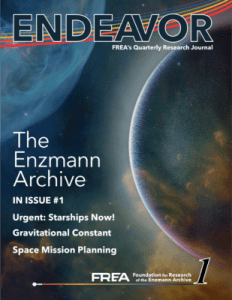Fact of the Matter: Order Theory
Holly Enzmann
Being a new recruit of FREA as Assistant Director, I have the opportunity every week to explore Enzmann’s extensive Archive. My current agenda calls for organizing and streamlining the plotlines of hundreds of unpublished science fiction stories he has written over the past 60+ years. I can say – hand to heart – my office is a magical place. We have two six-foot tables in the middle of the large Archive room, the walls of which are lined with filing cabinets, bookshelves, and computers. These allow us to loosely organize the material, including stories and timelines. The stories vary from being nearly completed to being scattered throughout packets of dot-matrix printouts, comb-bound manuscripts, scrapbook-like books, handwritten notes, and digital Word files of content.
We have decided to refer to the vast science fiction world he has created as The Enzmann Universe. It is a very long, ever-wobbling timeline exploring the successes, corruptions, trials, and endeavors of human cultures expanding into other solar systems and galaxies. I have discovered incredible and complex plotlines, all impressively supported by his 80 years in space mission planning, geology, military defense, and engineering. The programming, formulas, physics, technology, and peer-reviewed scientific development are incorporated into every chapter, bringing a sense of realism, relatability, and intrigue to the reader.
This aspect of Doc E’s writing is a significant asset to the potential success of the publication and popularity of any future books, but it also presents a huge challenge to any developmental editors assigned to streamlining and novelizing his work. One example could be the five pages we found calculating the distortion of light that forms the ever-debated phenomenon called a Starbow. We decided to digitize and include that one in this issue of the ENDEAVOR (see page 16).
Tediously typing out the formulas and digitizing the diagrams does develop a certain sense of familiarity and understanding of said subject, but the everyday sci-fi reader (or average Assistant Director) may not know what a subscript of a subscript within a formula represents mathematically. Even so, the stories hold their intrigue and sense of realism.
These examples are indeed challenging, especially now that the Great Doctor is no longer with us to translate for our future regurgitations. Luckily, we have his wife, Madam President, to provide clarity whenever we find ourselves filled with curiosity and have the mental capacity to learn.
As I read, I kept noticing Doc E’s references to his favorite complicated geophysics theory: Order Theory. I’m vaguely familiar with it from the astronomy lessons I had with him when I was younger. In a humble effort to explain what I have come to understand: it refers to the planetary formation processes broken out into specifically classified, sequential phases (therefore, “Order Theory”). In Doc E’s writing, he often includes the Order that whatever he is speaking about belongs to (-4th, +10th, -10th, etc.). I kept trying to look up what each order was online and found very little information. Questions started overwhelming my reading process, and I had to put the books down.
“What are the Orders? What does each one represent? Should I be saying, ‘what is the Order?’ How many Orders are there? Where do they start and finish? Do humans and animals belong to an Order? Does my cat belong to an Order?”
Thinking back fifteen years to our lessons and looking at old notebooks was not enough to help me understand many of his references, so I decided to take a stab at my own scientific research.
I thought my first attempt should be a direct dive into the Enzmann Archive. I pulled out various binders and packs of papers in the geology section and found work on geomorphology. The next step was the digital Archive, so I jumped into Non-Fiction > Cosmology and found numerous documents, all anywhere from 30 – 500 pages in length. Most are filled with seemingly unorganized information titled Cosmology, Space, or Time, and then other curiously titled pages like Unknowable Consistency or Dream Structure. Then a few pages down, you might find Self & Non-Self – The Brain’s Default-Mode Network. The information feels endless.
After an hour or two, I had many books open, printouts piled up, and written notes on my table for review. Doc E has part of his Order Theory published in the 1968 Geomorphology: Encyclopedia of Earth Science, called “Geomorphology – Expanded Theory,” so I added that to the piles on the table.
The first obvious observation I had was that there are both negative and positive orders. After some research, it appeared that the positive orders are universally agreed upon. The negative orders seem to have been developing over time, and their titles tend to be inconsistent. In Doc E’s 3rd Planetology and Space Mission Planning Conference publication from 1972, I found a breakdown of the negative orders (which I am still studying – updates to follow), and I read an observation note of his that says:
“In classical geomorphology, continents are 1st Order structures and 2nd Order in the expanded theory. Renumbering was done in 1958 to indicate complete geospheres as the Zero Order rotational oblateness and tidal prolateness as the 1st Order. Before that time, no designations of structures greater than continental platforms were in common usage, and one was needed for planetary and comparative interplanetary geophysics. This is the only change in classical geomorphology; the rest is an expansion to cosmology and quantum physics. The positive and negative numbering is an accident. No one foresaw an expansion to encompass the universe”.
I took that as confirmation that the negative Orders were still being developed at the time he was writing this due to unexpected growth in knowledge and understanding. I’m still looking for confirmation that the work was continued after Doc E retired.
Regardless, given these facts, I set the task of identifying the negative Orders aside and started researching positive Orders only. I went back to the geomorphology encyclopedia article. I found “Orders” in the index and flipped to page 404 to Geomorphology – Expanded Theory. It begins by stating that in classic geomorphology, modulation of Earth’s surface is divided into Orders, and the most common of these Orders are +1, +2, and +3:
+1st Order: Continental platforms and oceanic basins.
+2nd Order: Provincial features including continental shelves, coastal plains, old-lands, and mountain ranges.
+3rd Order: Massive structures such as single mountains, domes, basins.
Continuing to the tables, I found that each table was labeled something like “Geomorphic Features of the Earth’s Atmosphere,” or “Classification of Volumes within the Earth’s Lithosphere,” or “Features of Earth’s Endosphere.” Then each table had columns for orders 0-11, all with itemized lists of their characteristics.
I looked at the tables for a bit and quickly realized this would help me clarify what each order is in a conceptual sense but did not provide a direct definition of each, except for what was at the start of the chapter. I set the encyclopedia aside and moved back to the digital Archive.
The most definitive material I found was a random section in a 384-page document called Planetary Geospheres. Honestly, I felt like I had struck a gold mine. There was one page that listed orders +1 to +15 corresponding with all my notes and the encyclopedia tables – except for the fact that there are now 15 Orders, not 11. Regardless, I am pleased to type this out for you (instead of copy/pasting) to promote learning and knowledge:
+1st Order: geospheric (rotational) Oblateness and/or geospheric (tidal) Prolateness
+2nd Order: lithospheric Continental (platforms) Oceanic (basins)
+3rd Order: lithospheric Ocean Rifts. Continental Geosyncline-Geanticlines
+4th Order: lithospheric Batholithic Massifs
+5th Order: lithospheric Mass Waste-Boulders Rocks
+6th Order: lithospheric Psephites – Pebbly
+7th Order: lithospheric Psammites – Sandy
+8th Order: lithospheric Pelites – Muddy
+9th Order: lithospheric – Precipitates – Colloidal
+10th Order: Molecules
+11th Order: Elements
+12th Order: Nuclides (or Nucleotides?)
+13th Order: Quarks
+14th Order: Q.M
+15th Order: Æ
And there you have it, ladies and gentle-geodes! I will be the first to say that although I conceptually understand this sequence and its characteristics, I have quite a journey ahead of me before I understand its content. What are “Continental Geosyncline-Geanticlines”? What are “Pebbly Psephites”? Are they sand?
After finding this template, I started studying them, working my way up from Zero. My current understanding of 0th order (as Doc E calls it) is that it is the transfer of rotational energy around the geosphere’s axis that dictates its oblateness (flattening) and prolateness (elongating). My personal suspicion is that not only is 0th order the shape, but the actual transfer of energy into the form. I have not asked the higher powers to confirm this yet.
I don’t believe that learning or even memorizing the positive orders will be difficult, but the negative orders and the phases of formation they represent are really what interest me when it comes to reading the science fiction, which has more references to intergalactic geospheres and stellar groups than to our homogeneous planet.
The farther down the negative scale you go the larger the entity you are describing, and from what I have seen it spans from planets, comets, and asteroids to the universe as a whole. Maybe that’s the reason a readily available consensus of the sequence has not yet been reached. There is little consensus on what the universe is actually made of, how it functions, or how it came to be.
I’m embarking on a journey to make my way down the list of orders and define each one as plainly as possible. I decided that as a reward for my efforts, beyond gaining rare and fascinating knowledge of the subject (plus uninterrupted reading sessions), I would make a poster that I can hang on my wall, with each order sequentially listed top to bottom, 0th landing in the middle. I will publish it when it is created.
I invite you to join me as I share my findings, curiosities, and confirmations of Enzmann’s Order Theory through each issue of the ENDEAVOR. See you next time!





